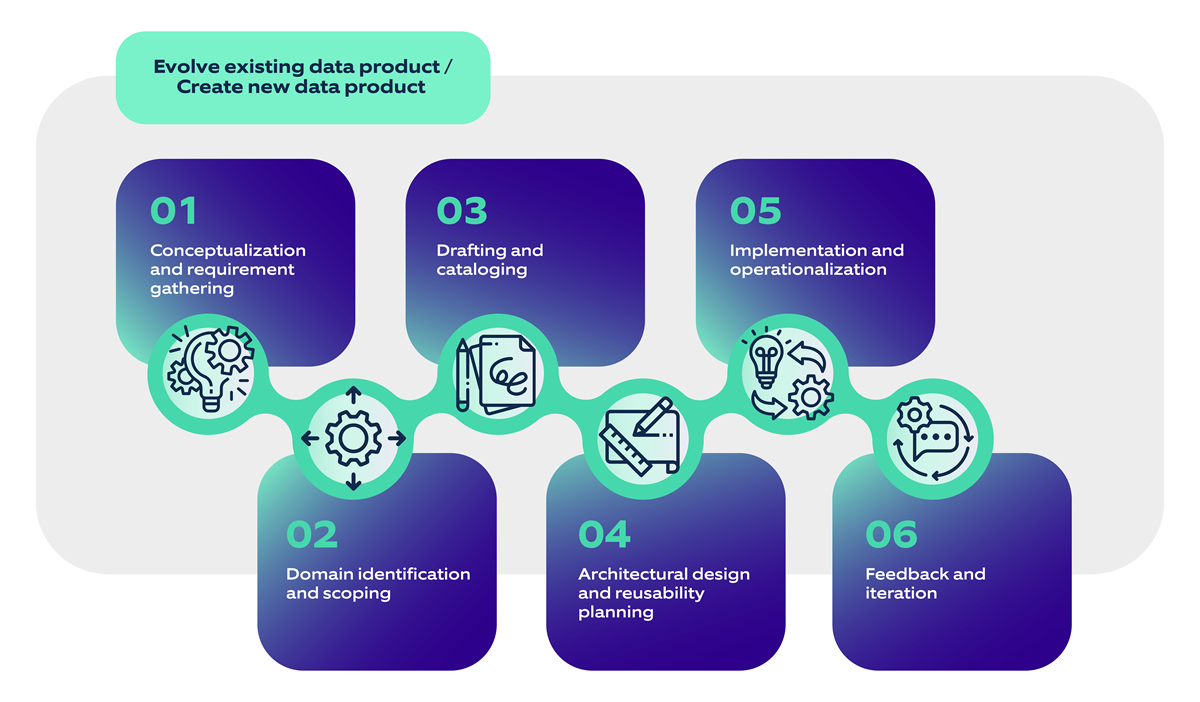Understanding data products
Today, data has become the nucleus of innovation and decision-making across industries. At the core of this data-driven transformation are data products.
What’s a data product, you ask? Let us tell you with an example!
The weather app on your phone that gives you personalized forecasts and saves you from rainy days is a data product. Similarly, the restaurant recommendation app you use on the weekends is a data product. Both these applications use raw data to deliver customized insights, empowering you to make informed choices.
In other words, a data product is a transformative solution that uses data to deliver actionable insights. As data becomes the key resource across business organizations, this blog looks at the limitations of the traditional data management approach and how the data product approach revolutionizes data management.
What’s more? We take you through a stepwise implementation of the data product approach and demonstrate how it helped an automotive company extract valuable business insights.
Limitations of traditional data management approach
- Centralized ownership: Centralized control limits department involvement in data quality and governance and restricts departments from experimenting and developing new solutions.
- Less agility: Traditional systems are slow to respond to changing business needs, requiring significant time and resources to make decisions and implement changes.
- Service model: Infrastructure is dedicated to specific applications and has limited user access, preventing data advancements.
- High service latency: Large applications struggle to meet diverse user needs simultaneously, causing significant latency and reducing usability.
Building blocks of data products
Data products turn raw data into actionable insights. They support diverse input types, process data to ensure high quality and generate varied outputs for different applications. Unlike traditional systems, Data Products ensure democratized access to data, driving intelligent decision-making.
Now, let us delve into the key components that make data products in more depth.

Fig 1: Core components of a data product
Input: A data product supports the ingestion of diverse input types, including batch and streaming data, which can be further classified based on structure – structured, semi-structured, and unstructured.
Core product: Data ingestion is followed by data processing to ensure that high-quality data is for user consumption. This is how data processing works:
Data processing framework: Implement a data processing framework to process data and implement Business logic for processing.
- Data modeling: Use the appropriate modeling technique to structure the data and store it according to the specific business use cases.
- Auditing and monitoring: Audit and monitor data to ensure uninterrupted data processing and track issues, if any.
- Data governance: Implement data governance aspects such as:
Data quality: Implement data quality rules to ensure high-quality data that enhances data value and decision-making capabilities.
Data security and access control: Manage access privileges to restrict unauthorized access and maintain data integrity.
Data catalog: Define the datasets and their fields to improve data knowledge and bridge the expertise gap.
Output: Ingest diverse data structures, process them with robust methods, and generate varied outputs for different downstream applications, such as event streams, APIs, and reports.
Control: Establish a highly qualified control mechanism which inhibits unnecessary manual intervention and ensures stakeholder involvement at the right time to overcome any hindrances in data processing. You can achieve this by ensuring:
- Orchestration: Automate data processing workflows for seamless execution.
- Alert mechanisms: Configure an alert mechanism to notify stakeholders in case of any failures.
Data product lifecycle

Fig 2: Data product lifecycle
Conceptualization and requirement gathering: Identify and document the core business requirements and use cases for the data product, ensuring they align with organizational goals.
Domain identification and scoping: determine the relevant subject areas and define the scope of the data product, including its target audience and key business use cases.
Drafting and cataloging: Draft a comprehensive blueprint for the data product and a catalog that includes metadata, architectural design, a data glossary, and business use cases.
Architectural design and reusability planning: design a reusable architecture for data products that ensures consistency and efficiency, allowing for future data products to be built upon this architecture.
Implementation and operationalization: implement the data product design, ensuring it meets the business requirements and is ready for use by the targeted audience.
Feedback and iteration: gather feedback on the deployed data product, capturing insights on issues, deviations, or missing features, and use this feedback to evolve the existing product or create new ones.
You can follow the same cycle for all the data products or enhance it as per your requirements.
Leveraging data products: solving traditional data challenges
Data products offer a transformative solution that directly addresses the issues encountered by traditional systems and offers the following benefits:
- Distributed ownership: distributed ownership gives departments control over data assets, enabling faster decision-making and quicker updates or feature development in response to new or changing requirements by providing team autonomy.
- Increased agility: the modularity approach ensures containment and independence, allowing quick adaptation to changing business needs and market conditions. This ensures features are rolled out with minimal latency.
- Self-service model: This model enables users to access data according to their requirements without requiring any intervention, resulting in faster data insights and increased data value.
- Low service latency: Application modularization significantly reduces service latency, making it easier to implement changes and adapt to new requirements. Thus, data is processed and provided faster to users.
Data product implementation
Having explored the fundamental aspects and benefits of the data product approach and its ability to address the challenges within traditional data management, we now focus on a real-world application.

Fig 3: Nagarro's approach towards designing data products
Nagarro recently partnered with an automotive company that wants to utilize the data product lifecycle to identify business opportunities and improve sales and marketing activities using data from customer insights, sales, and auctions.
What did the data product implementation roadmap look like? Let’s look at our step-by-step data product implementation approach:
Identify business goals and vision: We began with identifying and defining the business objective and strategic vision which was to leverage customer insights for improving sales and marketing effectiveness.
Select use cases: Once we knew the business goal and the vision, we identified the following use cases:
- Unified customer profile: The team integrated various data sources to create a comprehensive view of each customer.
- Vehicle information system: Developing a system to gather, manage, and utilize vehicle data.
- Bids & auctions: Managing and analyzing data from bidding and auction activities.
- Inventory tracking: Monitoring and managing Monitored and managed inventory levels and movements.
- Service history and sales transactions: Tracking service history and sales transactions to enhance customer service and sales strategies.
Business domains: Once we had identified the use cases, we classified them into respective business domains. This helped define the scope and ownership of the data products. Each use case was mapped to one business domain.
Data products: After identifying the use cases and corresponding domains, we conceptualized the data products and prepared implementation blueprints. The data products were further classified as analytical and operational.

Fig 4: Implementation of a data product
The implementation comprised of five components:
- Source systems: Processing and preparing the applications that provided the data by the data products.
- Enterprise layer: Storing and processing all the data in the foundational storage component.
- Operational data products: Creating intermediate data products from the foundational enterprise layer to support various operational needs addressing the operational use cases.
- Analytical data products: Derive analytical insights from the operational data products, the foundational layer, or both. In this case, we used Customer 360, which offered a comprehensive customer view, incorporating data from multiple sources to provide a holistic understanding.
- Consumption: Driving business actions and decisions using the operational and analytical data products to fulfil the business use cases.
The data product approach –not just a technical upgrade; it’s a strategic business imperative
Data products represent a significant shift in data management, addressing the limitations of traditional approaches. By enabling distributed ownership, promoting agility, and reducing latency, data products empower organizations to leverage data more effectively. This leads to faster decision-making, improved adaptability to market changes, and the ability to extract valuable insights from raw data.
In a world where data drives innovation and competitive advantage, adopting a data product approach positions organizations for success. Nagarro's example illustrates the journey from conceptualization to implementation, highlighting the practical steps and strategic benefits of embracing data products.
As businesses continue to navigate the complexities of the digital era, data products offer a versatile and powerful solution. They not only streamline data management but also democratize access to data insights, enabling all users to make informed decisions. By integrating data products into their operations, organizations can achieve cost reduction, operational efficiency, and enhanced customer service.





